Heat Transfer Augmentation and Entropy Generation Analysis of Microchannel Heat Sink (MCHS) with Symmetrical Ogive-Shaped Ribs
Abstract
:1. Introduction
2. Materials and Methods
2.1. Physical Model Description
2.2. Governing Equations
2.3. Data Deduction
2.4. Grid Independent Study
3. Results and Discussion
3.1. Results Validation
3.2. Flow Characteristics
3.3. Thermal Characteristics
3.4. Entropy Generation Analysis
3.5. Pumping Power Requirement
3.6. Thermal Enhancement Factor ()
3.7. Exergy Analysis
4. Conclusions
- The inclusion of symmetrical ogive shape rib configurations on smooth MCHS channel walls improves its thermal performance by increasing the average Nusselt number. The MC-SAWR configuration gives the maximum Nusselt number improvement, increasing the Nusselt number of smooth MCHS by 2.04 times at Re = 1000.
- Symmetrical ogive rib configurations lower the thermal resistance of MCHS by improving the heat transfer coefficient and increasing the channel wall surface area for heat dissipation. The MC-SAWR configuration shows the maximum reduction in thermal resistance, reducing the thermal resistance of smooth MCHS by 46%.
- The addition of symmetrical ogive ribs on smooth MCHS channel walls is effective in reducing the entropy generation rate associated with MCHS. MCHS configurations with symmetrical ogive ribs demonstrate augmentation entropy generation lower than one at all Re values, with the MC-SAWR configuration showing the lowest augmentation entropy generation value of 0.42, reducing the irreversibilities associated with smooth MCHS by 58%.
- Symmetrical ogive ribs improve the thermal performance of MCHS, and they also result in a significant rise in pressure drop. Therefore, more external pumping energy is required for heat dissipation from MCHS.
- The thermal enhancement factor is greater than one for MC-SSWR and MC-SBWR configurations at all Re values, while for MC-SAWR configuration, it is greater than one at all Re values except at Re = 100. A thermal enhancement factor greater than one implies that the improvement of MCHS performance due to symmetrical ogive ribs from a thermal standpoint is more significant than the deterioration of system performance due to high pumping power requirement.
- Based on the augmentation entropy generation number and thermal enhancement factor criterion, the MC-SAWR configuration is the best configuration at Re greater than 100. Although the MC-SAWR configuration has a lower thermal enhancement factor than the MC-SSWR and MC-SBWR configurations at Re less than 400, this low thermal enhancement factor due to higher pressure losses is balanced by its lower augmentation entropy generation number, giving a superior cooling performance.
Author Contributions
Funding
Data Availability Statement
Acknowledgments
Conflicts of Interest
Nomenclature
| A | |
| Diameter of ogive rib, mm | |
| Hydraulic diameter, mm | |
| f | Friction factor |
| H | Height, mm |
| Height of channel, mm | |
| k | |
| L | Length, mm |
| Length of ogive rib, mm | |
| MCHS | Microchannel heat sink |
| MC-SC | Microchannel with smooth channel |
| MC-SAWR | MCHS with ribs mounted on all channel walls |
| MC-SSWR | MCHS with ribs mounted on side-channel walls |
| MC-SBWR | MCHS with ribs mounted on only the bottom wall of the channel |
| Augmentation entropy generation number | |
| Nu | Nusselt number |
| Pressure drop, Pa | |
| Q | |
| Re | Reynolds number |
| Thermal resistance, K/W | |
| Total volumetric entropy generation rate | |
| Entropy generation rate due to heat transfer | |
| Entropy generation rate due to pressure drop | |
| T | Temperature, K |
| Average base wall temperature | |
| T | Temperature difference, K |
| Mean velocity, m/s | |
| u | Velocity component in x direction, m/s |
| v | Velocity component in y direction, m/s |
| w | Velocity component in z direction, m/s |
| W | Width, mm |
| Width of channel, mm | |
| Greek Symbols | |
| Dynamic viscosity, Pa s | |
| Thermal enhancement factor | |
| Thermal transport efficiency | |
| Subscripts | |
| w | Wall |
| s | Solid |
| f | Fluid |
| th | Total |
| in | Inlet |
| out | Outlet |
References
- Tuckerman, D.B.; Pease, R.F.W. High-performance heat sinking for VLSI. IEEE Electron. Device Lett. 1981, 2, 126–129. [Google Scholar] [CrossRef]
- Wang, H.; Chen, Z.; Gao, J. Influence of geometric parameters on flow and heat transfer performance of micro-channel heat sinks. Appl. Therm. Eng. 2016, 107, 870–879. [Google Scholar] [CrossRef]
- Dewan, A.; Srivastava, P. A review of heat transfer enhancement through flow disruption in a microchannel. J. Therm. Sci. 2015, 24, 203–214. [Google Scholar] [CrossRef]
- Datta, A.; Sharma, V.; Sanyal, D.; Das, P. A conjugate heat transfer analysis of performance for rectangular microchannel with trapezoidal cavities and ribs. Int. J. Therm. Sci. 2019, 138, 425–446. [Google Scholar] [CrossRef]
- Wang, G.; Niu, D.; Xie, F.; Wang, Y.; Zhao, X.; Ding, G. Experimental and numerical investigation of a microchannel heat sink (MCHS) with micro-scale ribs and grooves for chip cooling. Appl. Therm. Eng. 2015, 85, 61–70. [Google Scholar] [CrossRef]
- Ahmad, F.; Cheema, T.A.; Rehman, M.M.U.; Ilyas, M.; Park, C.W. Thermodynamic Analysis of Microchannel Heat Sink with Cylindrical Ribs and Cavities. J. Heat Transf. 2020, 142, 092503. [Google Scholar] [CrossRef]
- Khan, A.A.; Kim, S.-M.; Kim, K.-Y. Performance Analysis of a Microchannel Heat Sink with Various Rib Configurations. J. Thermophys. Heat Transf. 2016, 30, 782–790. [Google Scholar] [CrossRef]
- Ghani, I.A.; Kamaruzaman, N.; Sidik, N.A.C. Heat transfer augmentation in a microchannel heat sink with sinusoidal cavities and rectangular ribs. Int. J. Heat Mass Transf. 2017, 108, 1969–1981. [Google Scholar] [CrossRef]
- Li, Y.; Xia, G.; Ma, D.; Jia, Y.; Wang, J. Characteristics of laminar flow and heat transfer in microchannel heat sink with triangular cavities and rectangular ribs. Int. J. Heat Mass Transf. 2016, 98, 17–28. [Google Scholar] [CrossRef]
- Zhai, Y.; Xia, G.; Liu, X.; Li, Y. Exergy analysis and performance evaluation of flow and heat transfer in different micro heat sinks with complex structure. Int. J. Heat Mass Transf. 2015, 84, 293–303. [Google Scholar] [CrossRef]
- Zhai, Y.; Xia, G.; Liu, X.; Li, Y. Heat transfer in the microchannels with fan-shaped reentrant cavities and different ribs based on field synergy principle and entropy generation analysis. Int. J. Heat Mass Transf. 2014, 68, 224–233. [Google Scholar] [CrossRef]
- Li, P.; Luo, Y.; Zhang, D.; Xie, Y. Flow and heat transfer characteristics and optimization study on the water-cooled microchannel heat sinks with dimple and pin-fin. Int. J. Heat Mass Transf. 2018, 119, 152–162. [Google Scholar] [CrossRef]
- Rehman, M.M.U.; Cheema, T.A.; Ahmad, F.; Abbas, A.; Malik, M.S. Numerical investigation of heat transfer enhancement and fluid flow characteristics in a microchannel heat sink with different wall/design configurations of protrusions/dimples. Heat Mass Transf. 2020, 56, 239–255. [Google Scholar] [CrossRef]
- Rehman, M.M.U.; Cheema, T.A.; Ahmad, F.; Khan, M.; Abbas, A. Thermodynamic Assessment of Microchannel Heat Sinks with Novel Sidewall Ribs. J. Thermophys. Heat Transf. 2020, 34, 243–254. [Google Scholar] [CrossRef]
- Ahmad, F.; Cheema, T.A.; Ur Rehman, M.M.; Abbas, A.; Park, C.W. Thermal enhancement of microchannel heat sink using rib surface refinements. Numer. Heat Transf. Part A Appl. 2019, 76, 851–870. [Google Scholar] [CrossRef]
- Li, Y.; Xia, G.; Jia, Y.; Ma, D.; Cai, B.; Wang, J. Effect of geometric configuration on the laminar flow and heat transfer in microchannel heat sinks with cavities and fins. Numer. Heat Transf. Part A Appl. 2017, 71, 528–546. [Google Scholar] [CrossRef]
- Xia, G.; Chai, L.; Wang, H.; Zhou, M.; Cui, Z. Optimum thermal design of microchannel heat sink with triangular reentrant cavities. Appl. Therm. Eng. 2011, 31, 1208–1219. [Google Scholar] [CrossRef]
- Ahmad, F.; Cheema, T.A.; Khan, A.; Mohib-Ur-Rehman, M.; Yildizhan, H. Hydrothermal Investigation of the Performance of Microchannel Heat Sink with Ribs Employed on Side Walls. J. Non-Equilib. Thermodyn. 2021, 46, 255–272. [Google Scholar] [CrossRef]
- Zhang, S.; Ahmad, F.; Ali, H.; Ali, S.; Akhtar, K.; Ali, N.; Badran, M. Computational Study of Hydrothermal Performance of Microchannel Heat Sink with Trefoil Shape Ribs. IEEE Access 2022, 10, 74412–74424. [Google Scholar] [CrossRef]
- Ali, S.; Ahmad, F.; Akhtar, K.; Habib, N.; Aamir, M.; Giasin, K.; Vafadar, A.; Pimenov, D.Y. Numerical Investigation of Microchannel Heat Sink with Trefoil Shape Ribs. Energies 2021, 14, 6764. [Google Scholar] [CrossRef]
- Ali, S.; Ahmad, F.; Hassan, M.; Rehman, Z.; Wadood, A.; Ahmad, K.; Park, H. Thermo-Fluid Characteristics of Microchannel Heat Sink with Multi-Configuration NACA 2412 Hydrofoil Ribs. IEEE Access 2021, 9, 128407–128416. [Google Scholar] [CrossRef]
- ‘Ogive Shape’, Wikipedia. Available online: https://en.wikipedia.org/wiki/Ogive#:~:text=An%20ogive%20or%20ogival%20arch,the%20same%20as%20the%20width (accessed on 8 August 2021).
- Chalia, S.; Bharti, M.K. Mathematical modeling of ogive forebodies and nose cones. Int. Res. J. Eng. Technol. IRJET 2016, 3, 744–747. [Google Scholar]
- Zimparov, V. Extended performance evaluation criteria for enhanced heat transfer surfaces: Heat transfer through ducts with constant wall temperature. Int. J. Heat Mass Transf. 2000, 43, 3137–3155. [Google Scholar] [CrossRef]
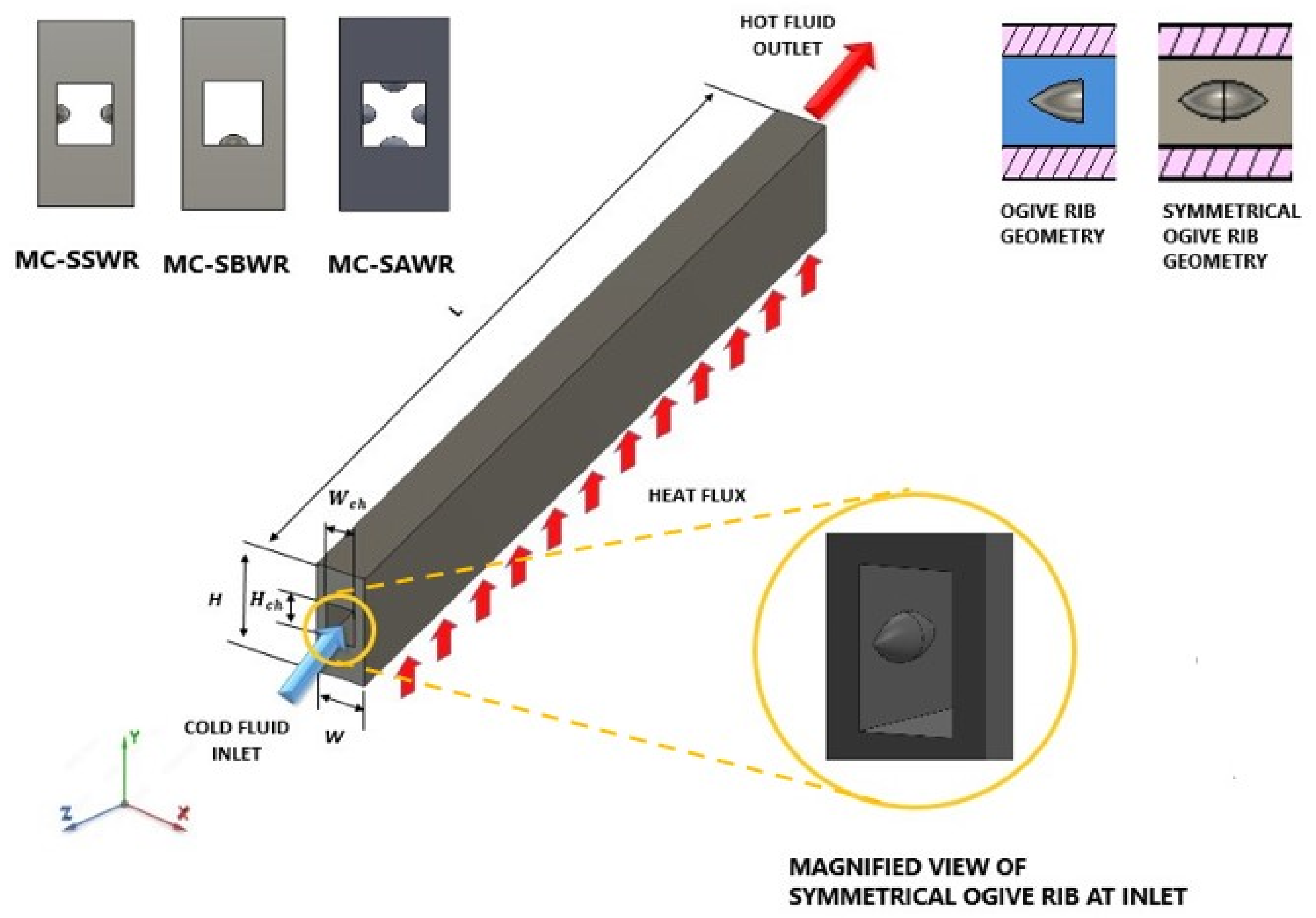
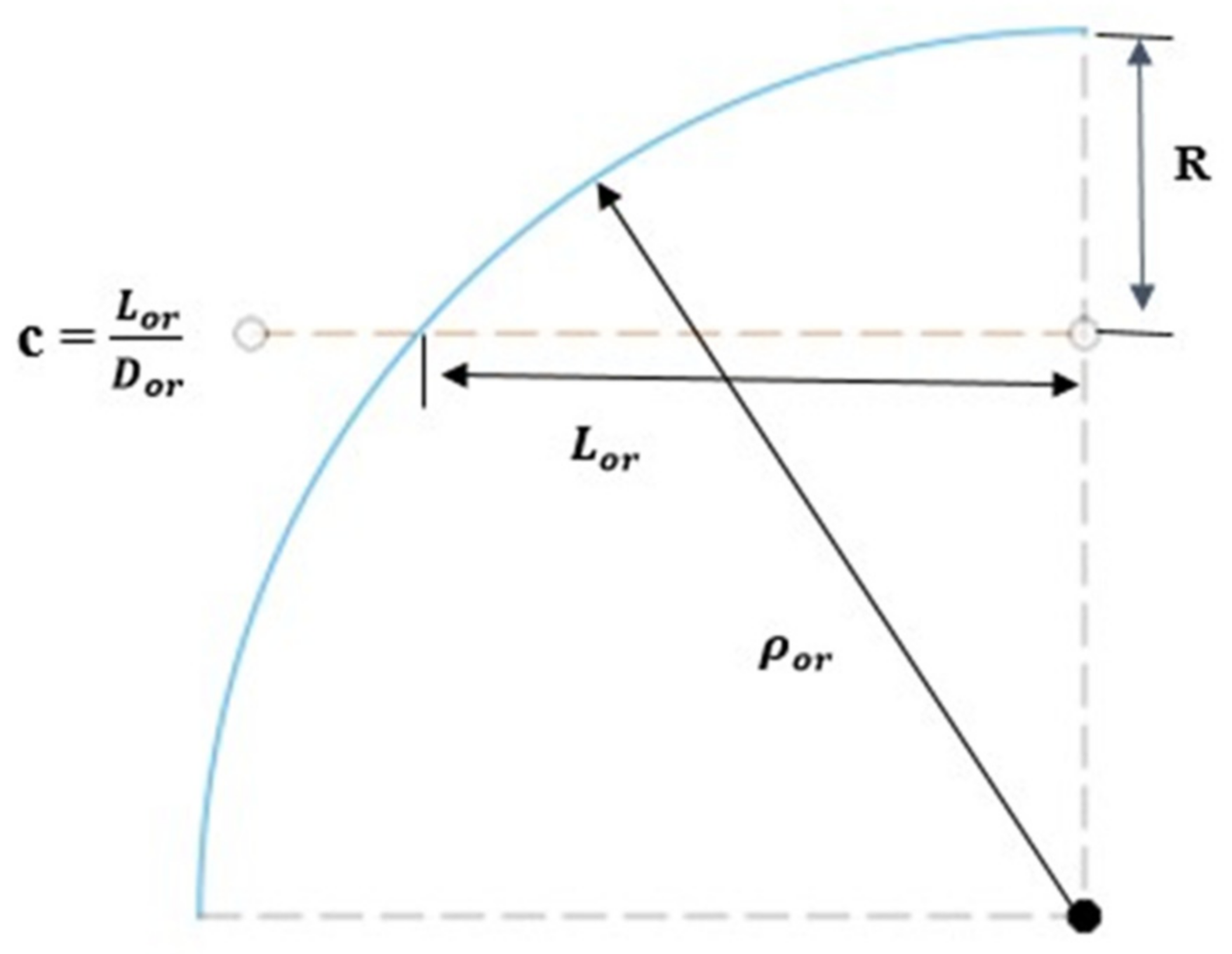
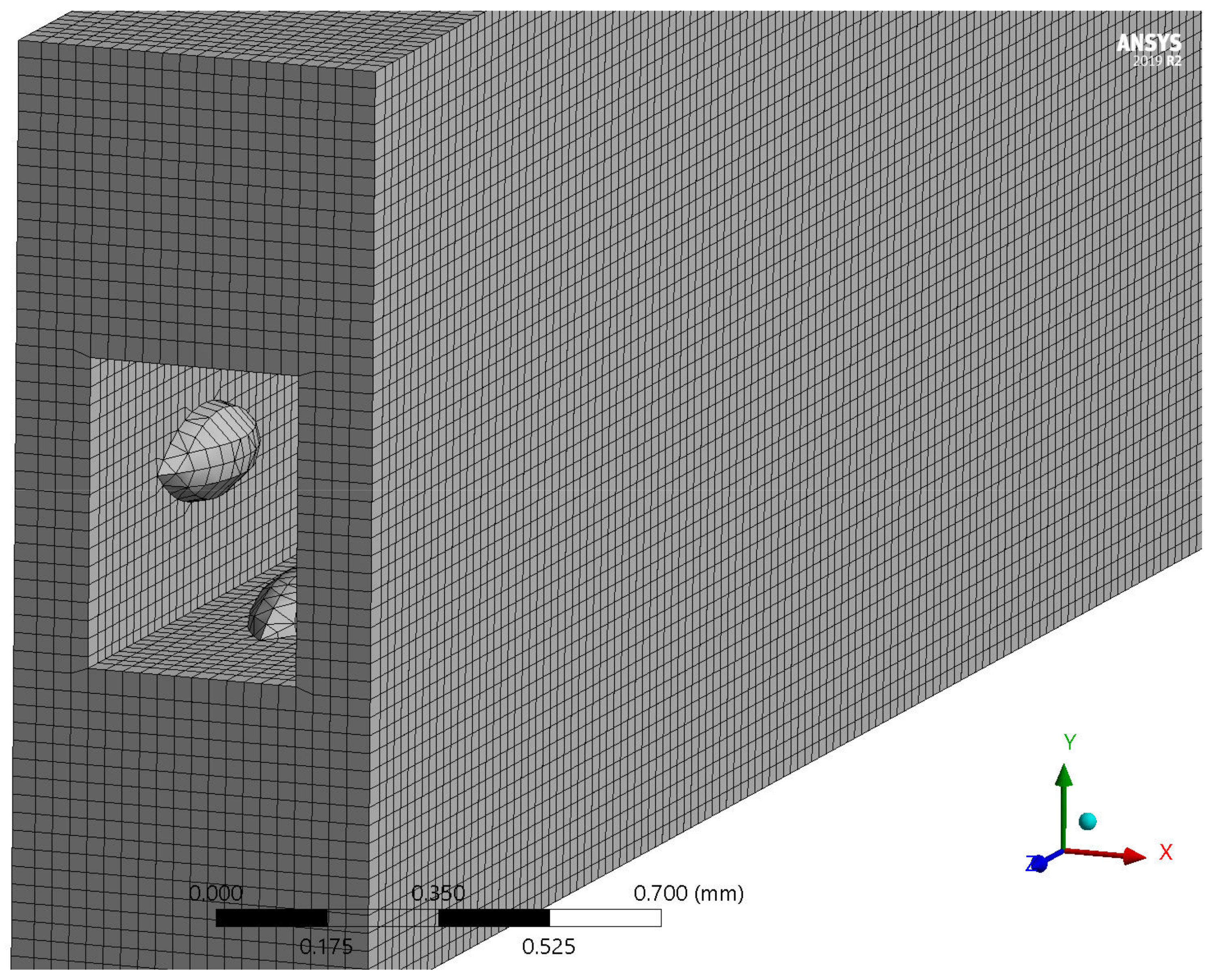
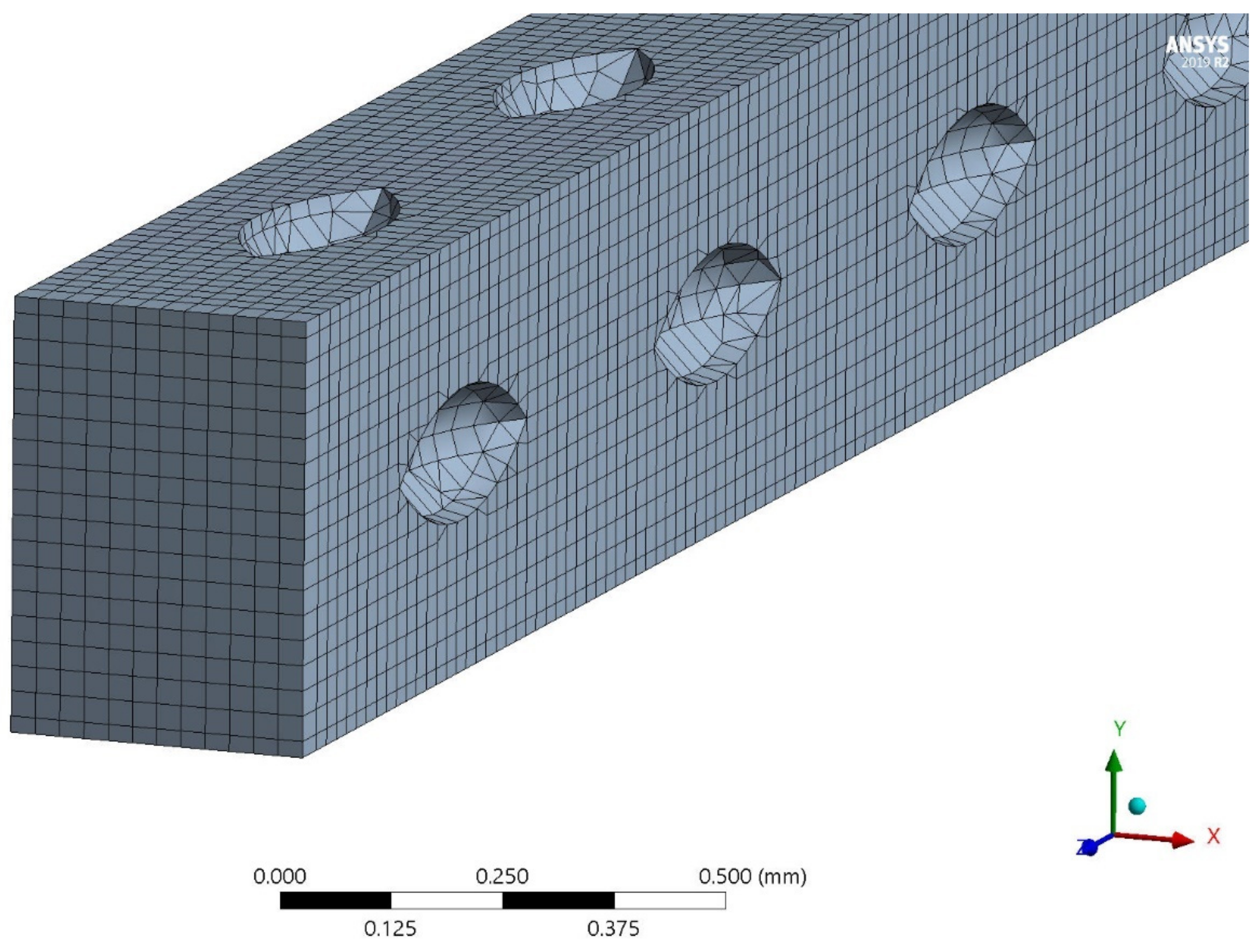
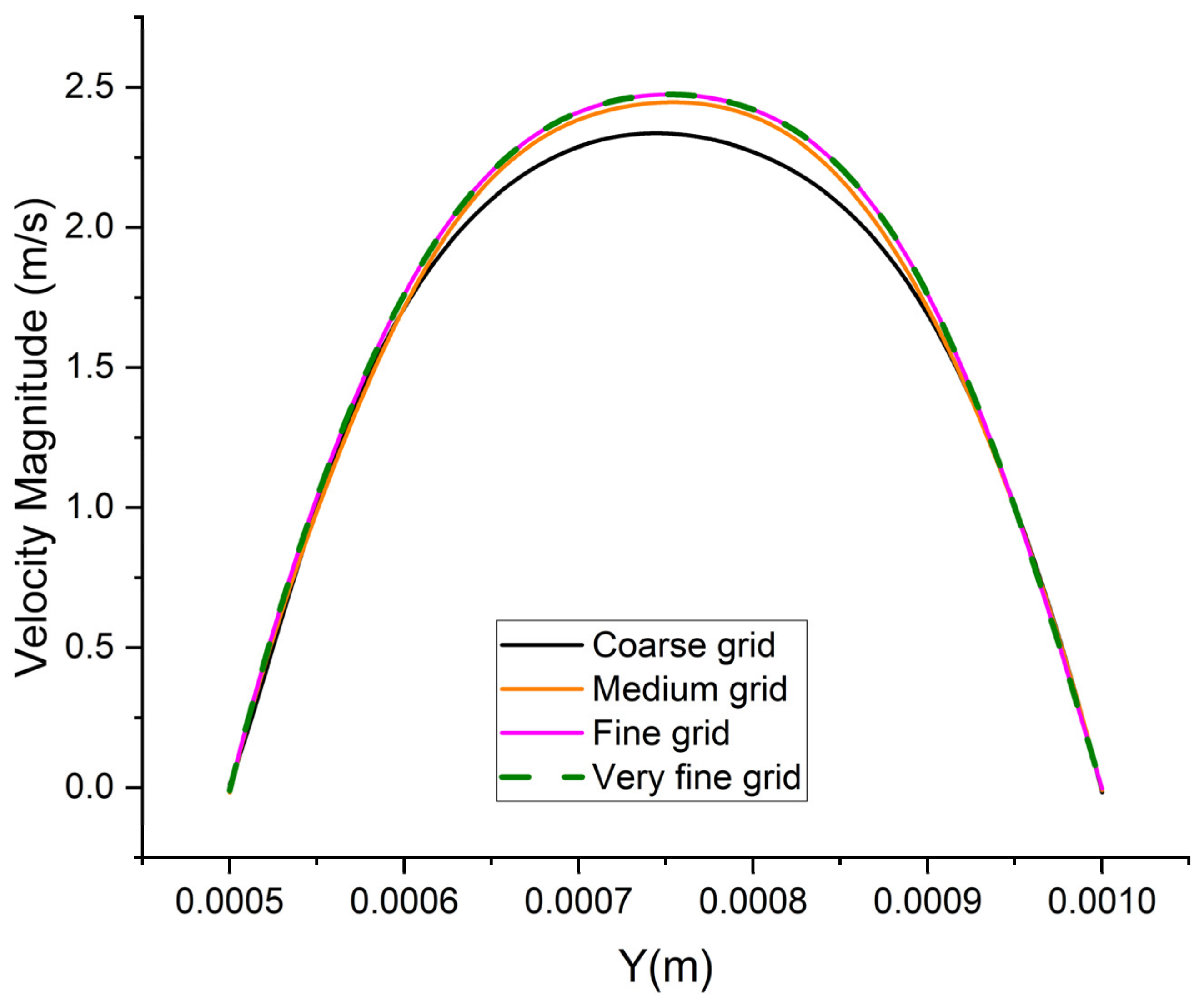

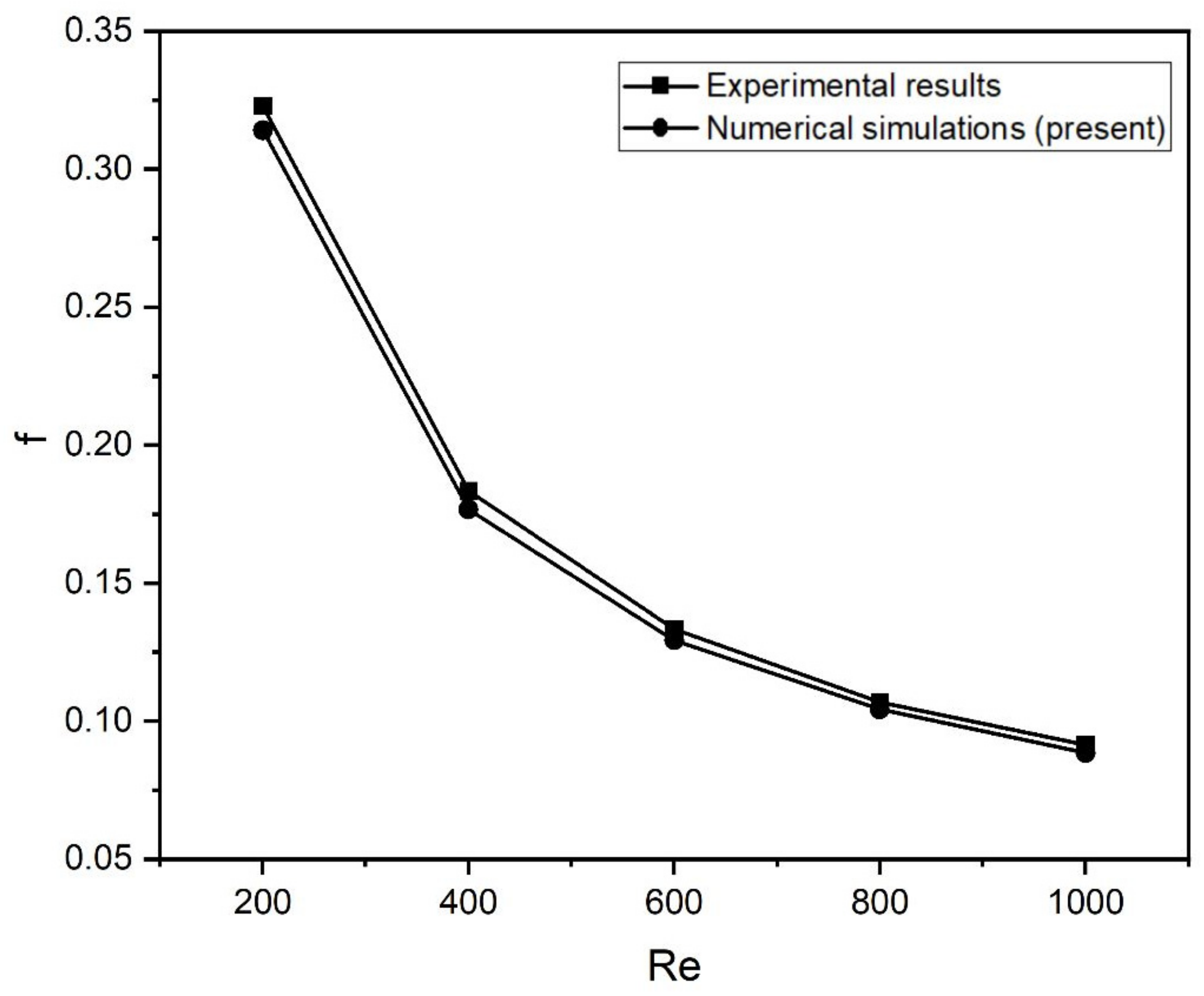


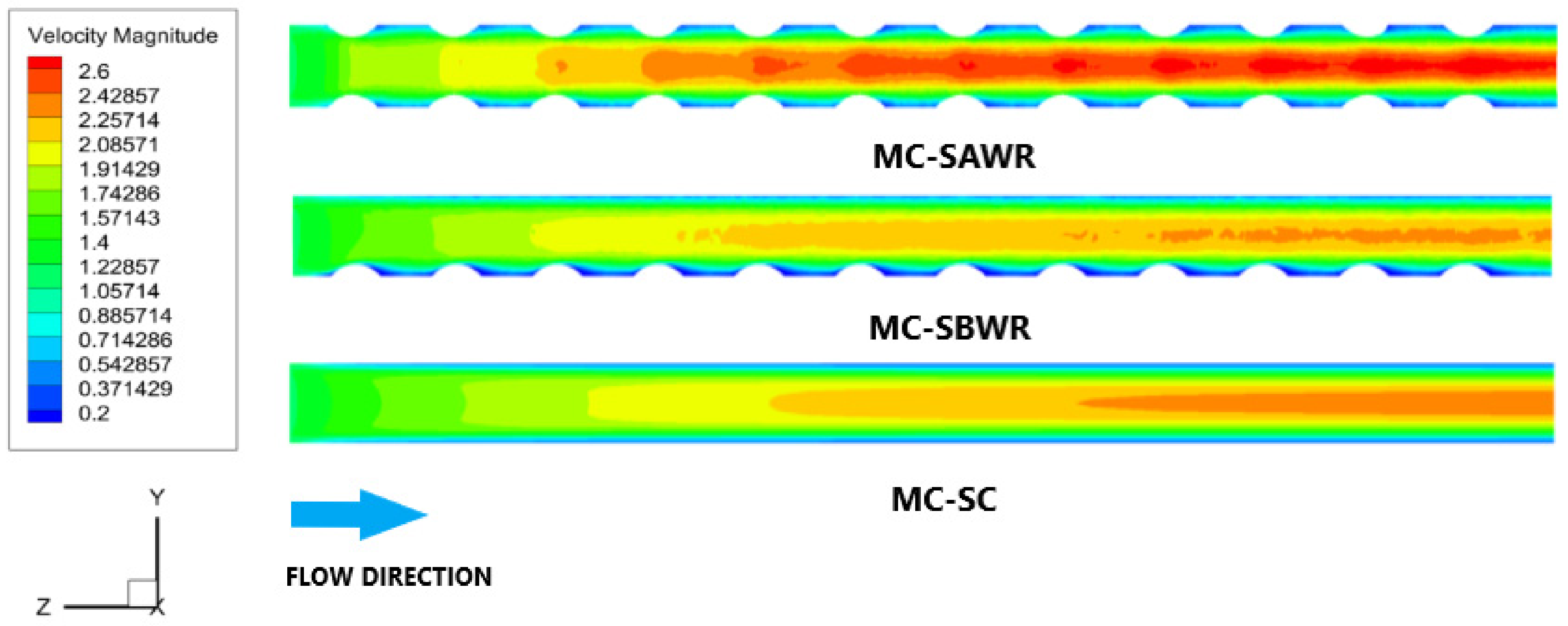
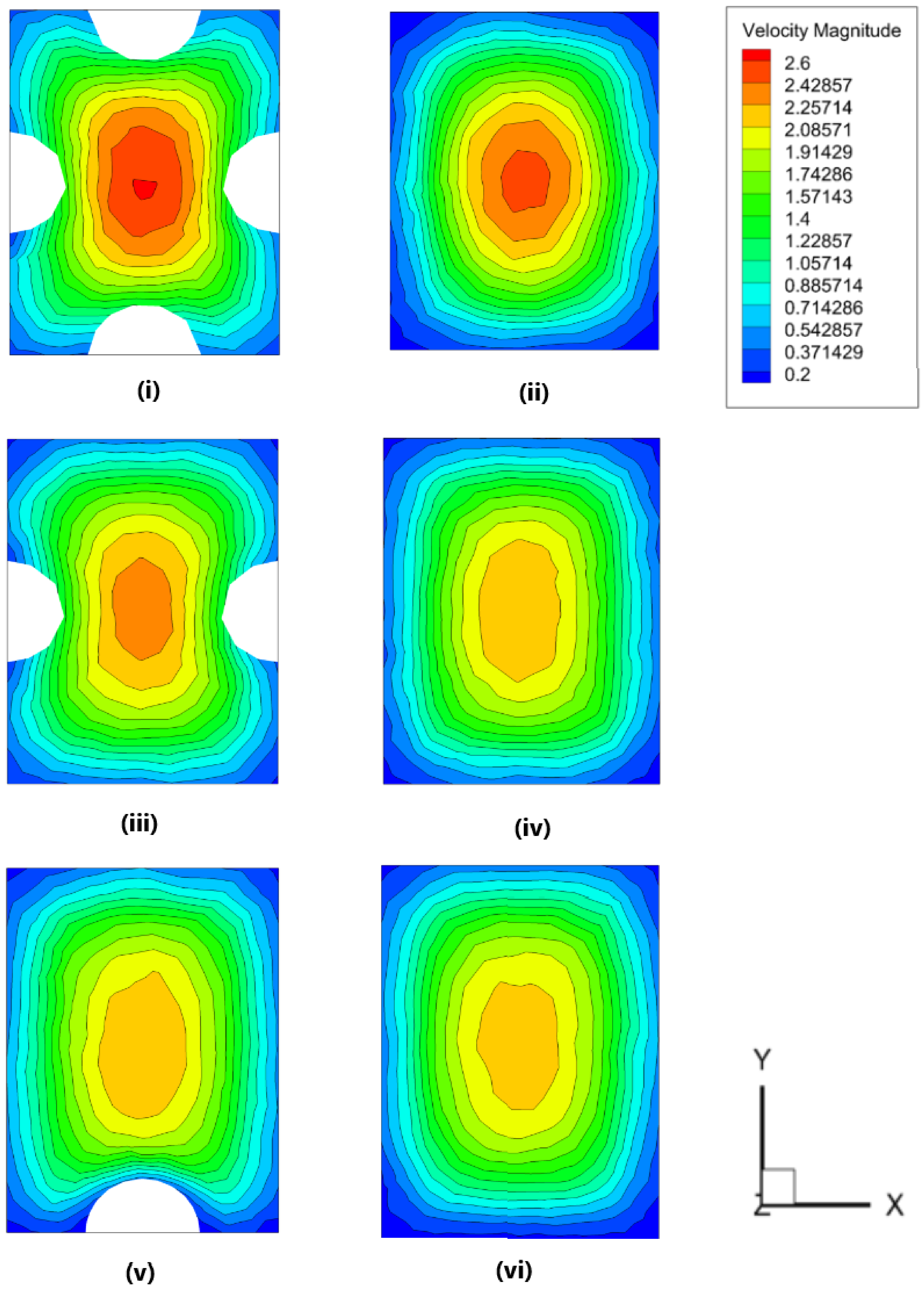
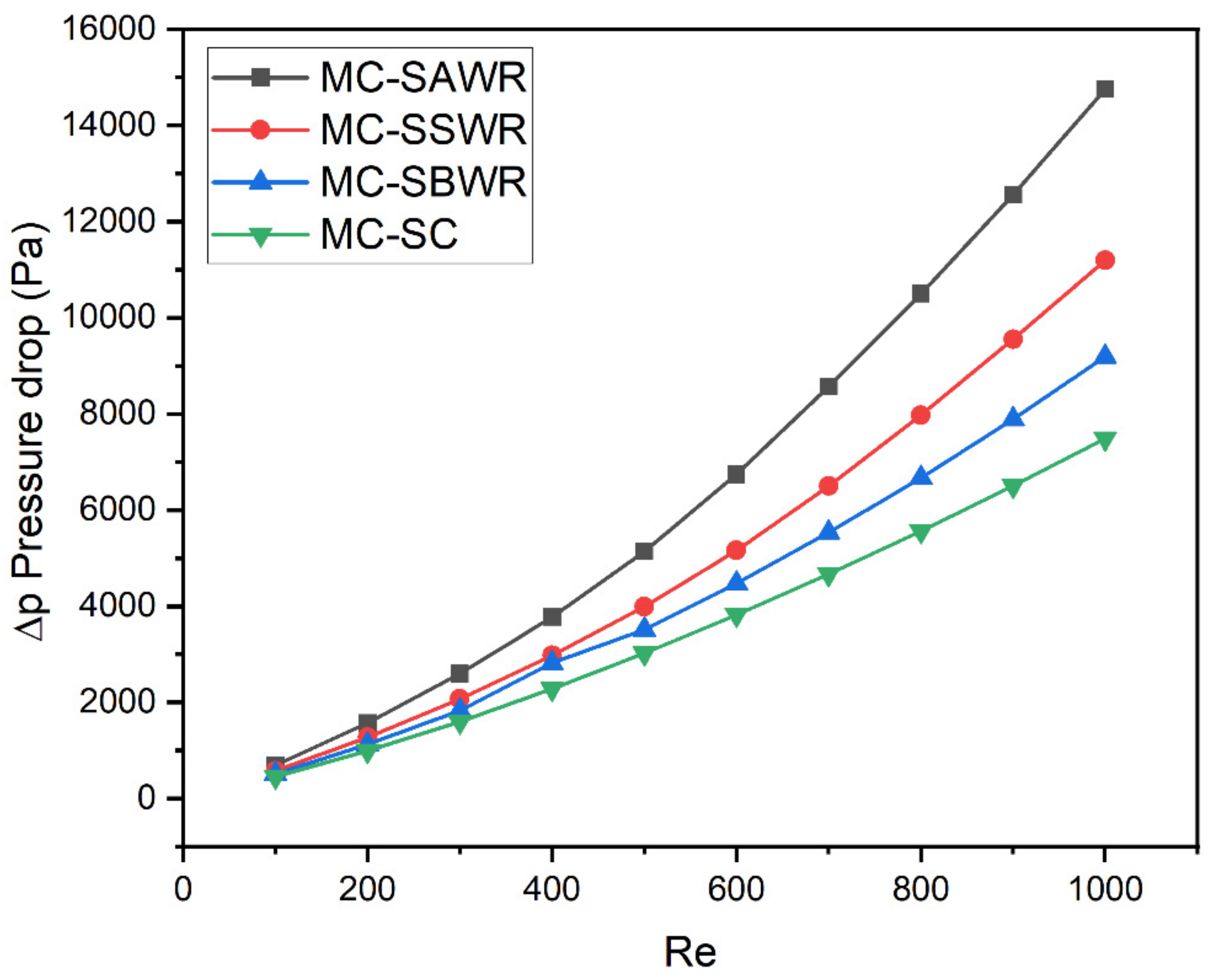
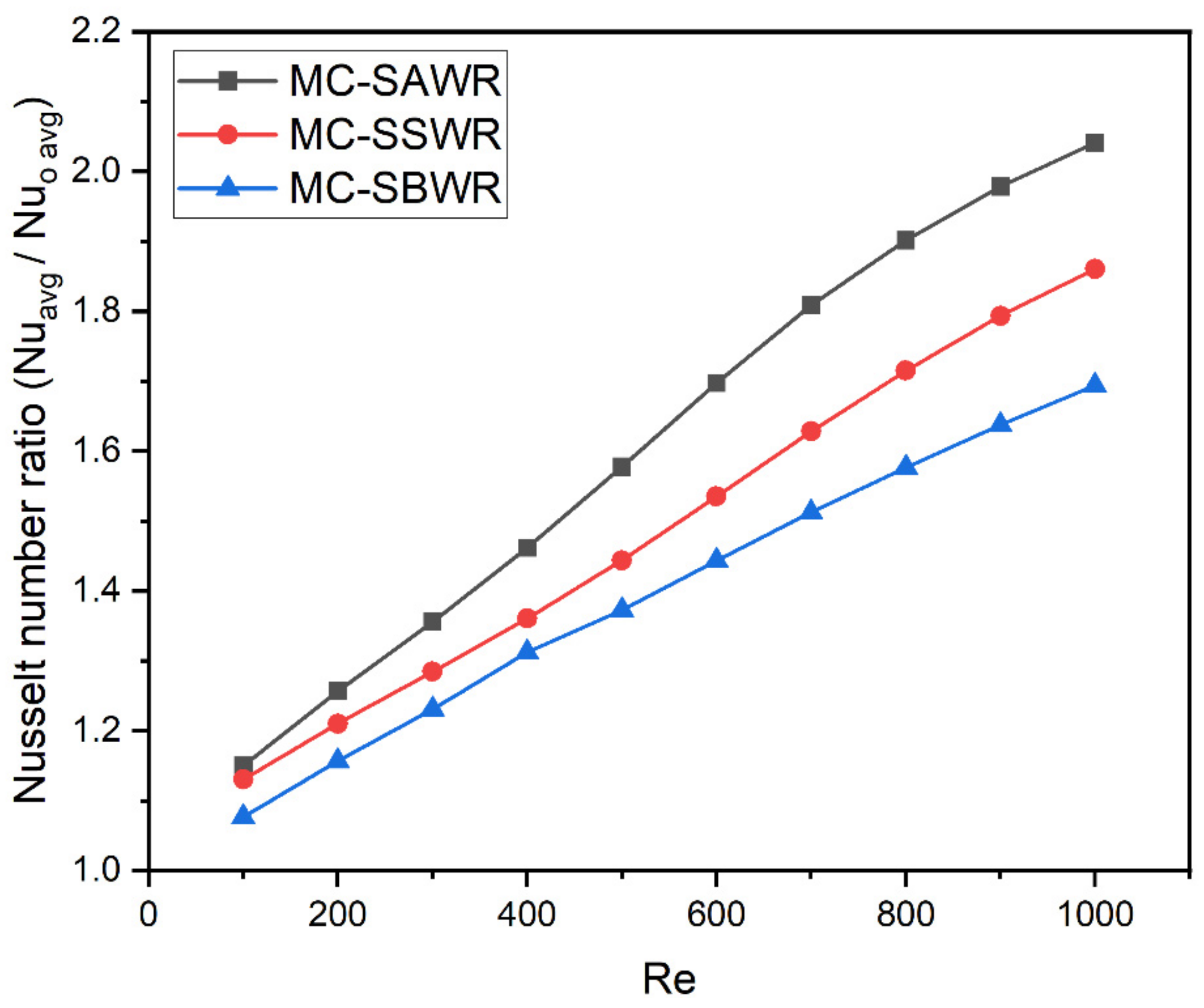

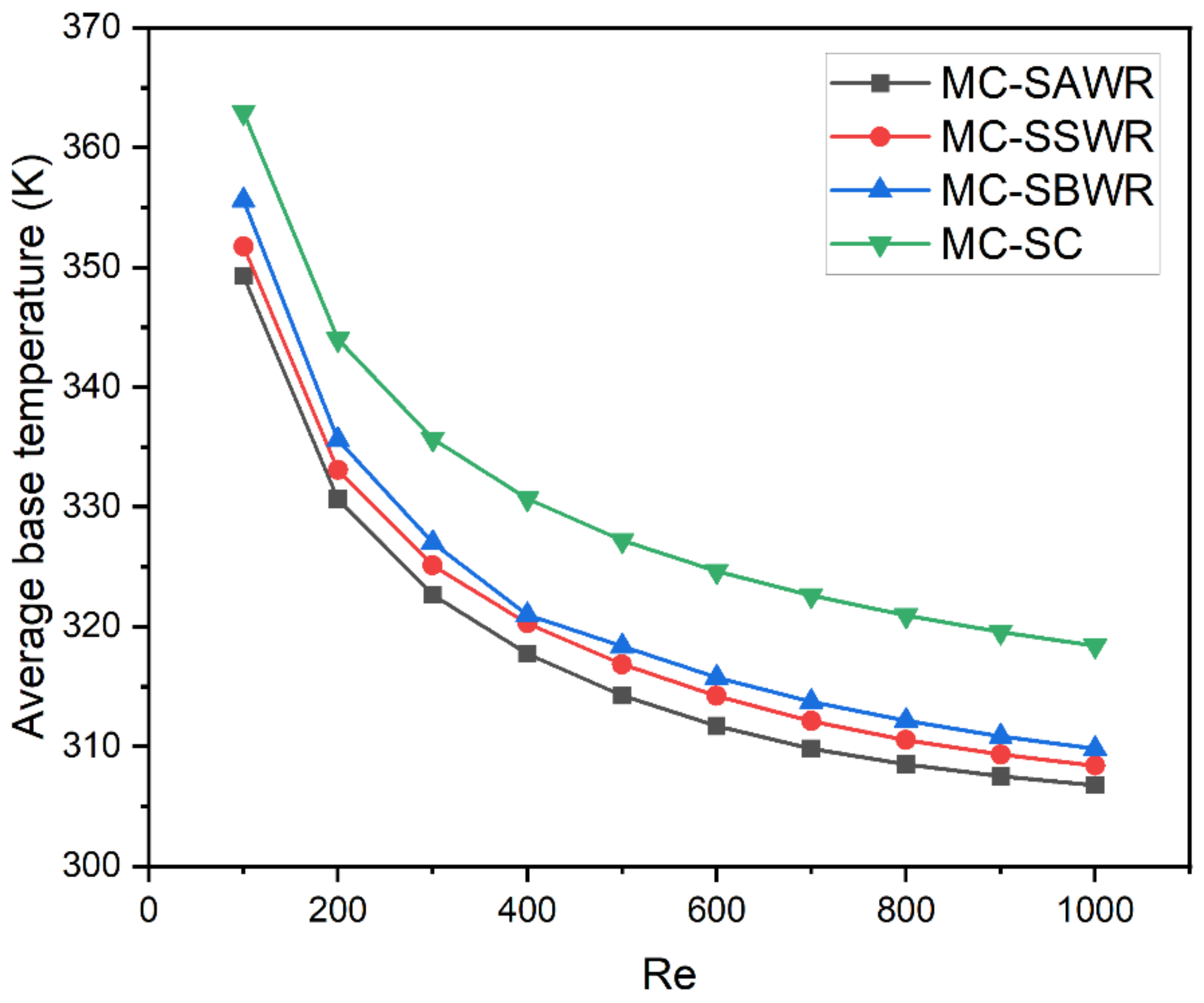
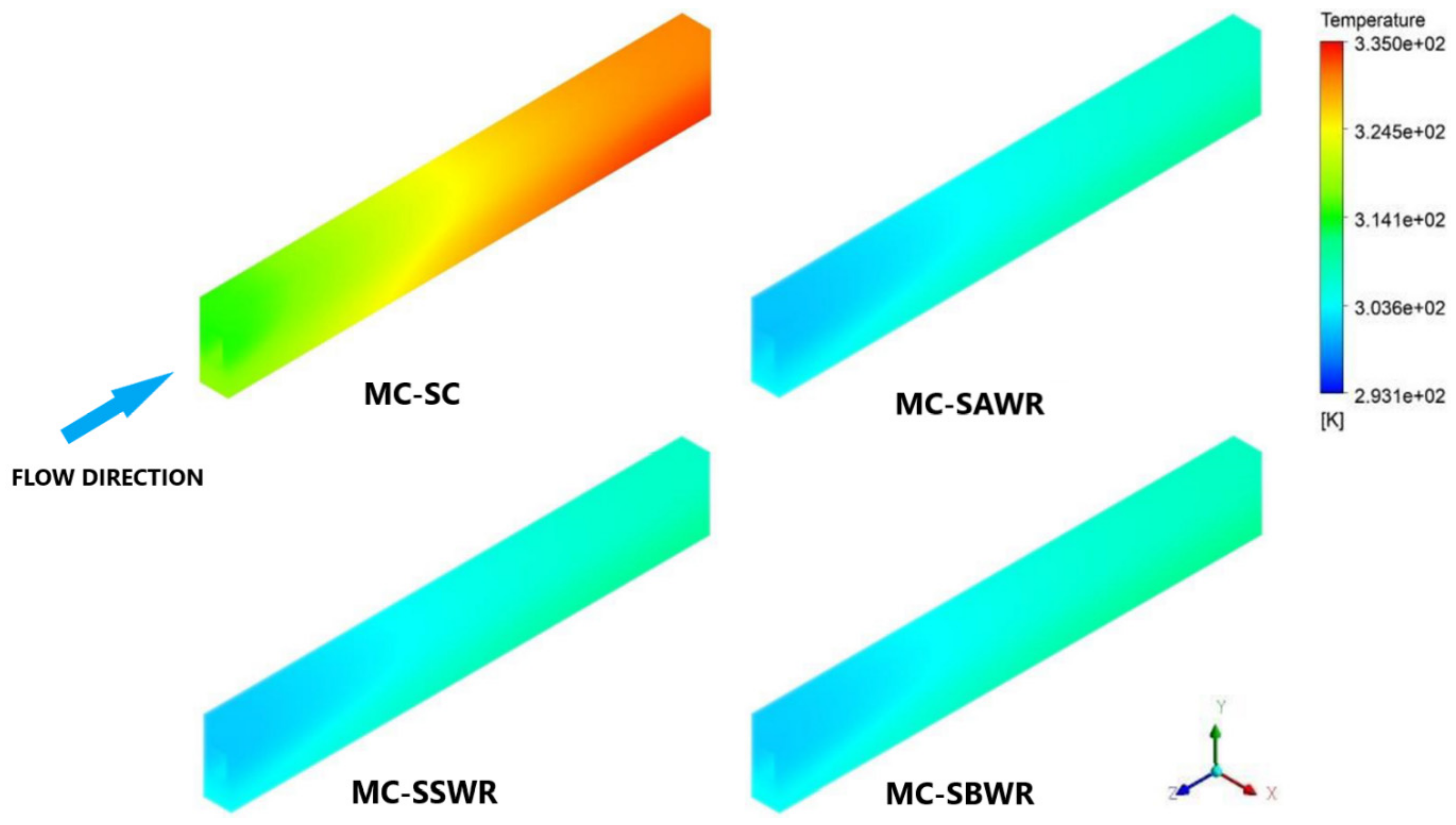
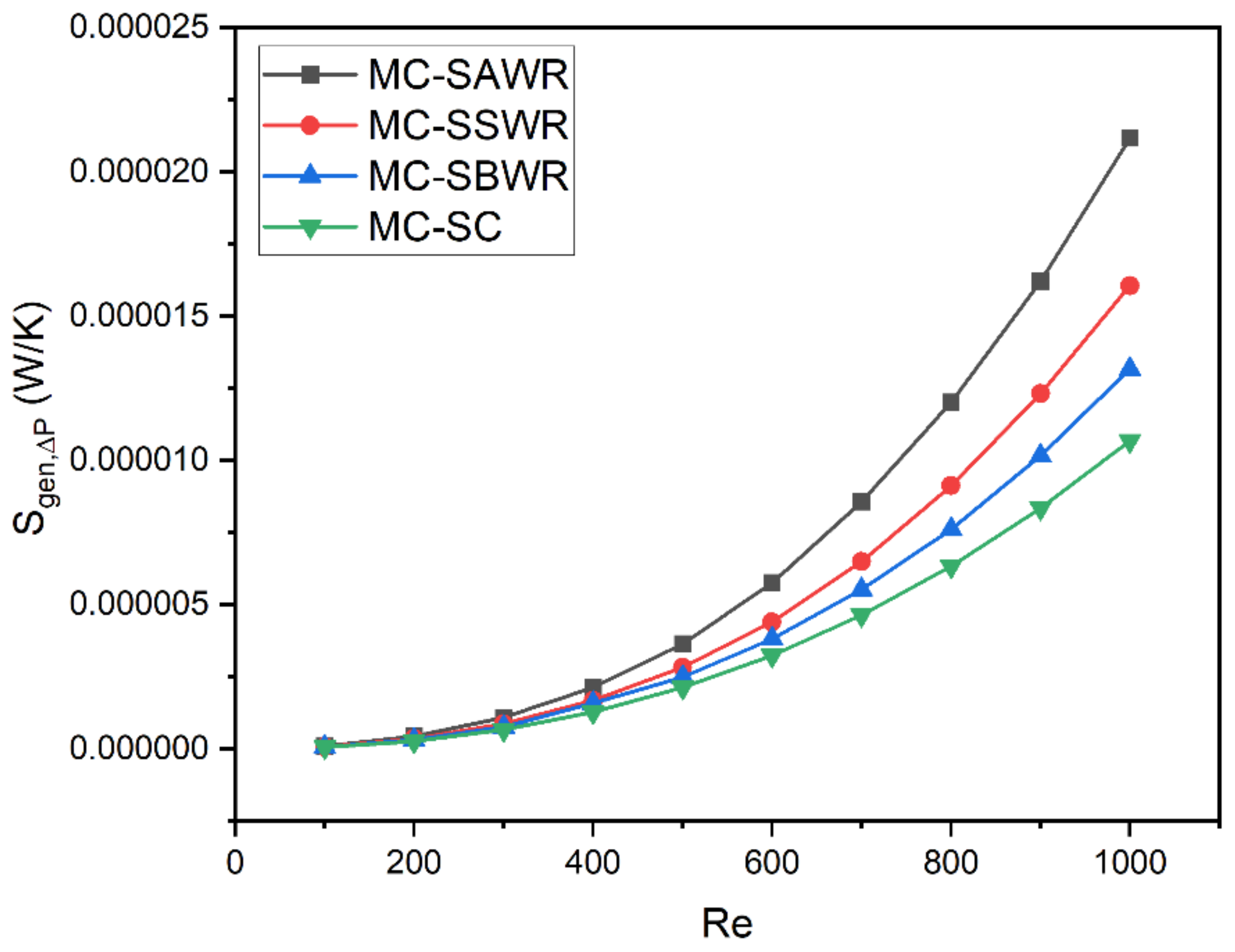
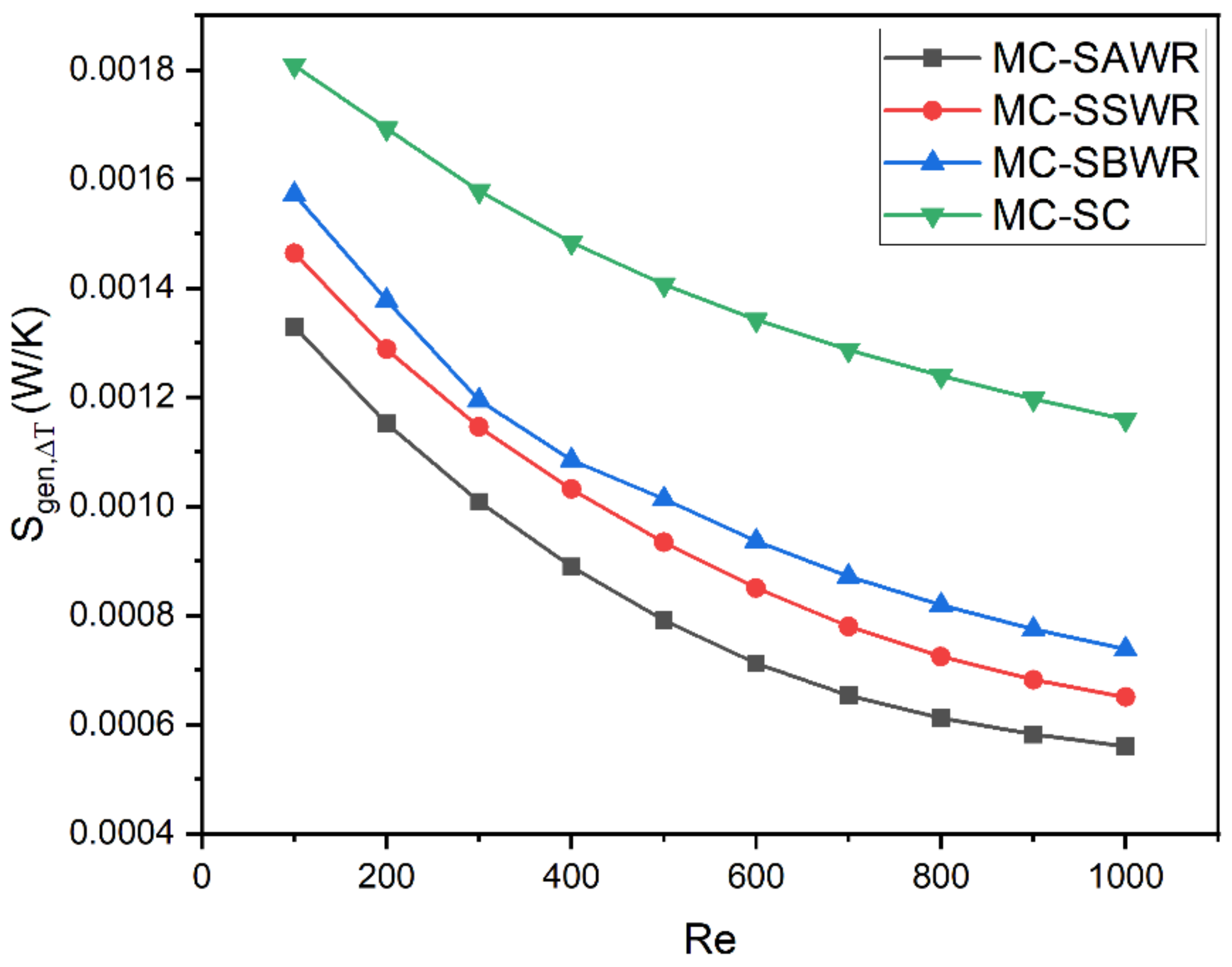

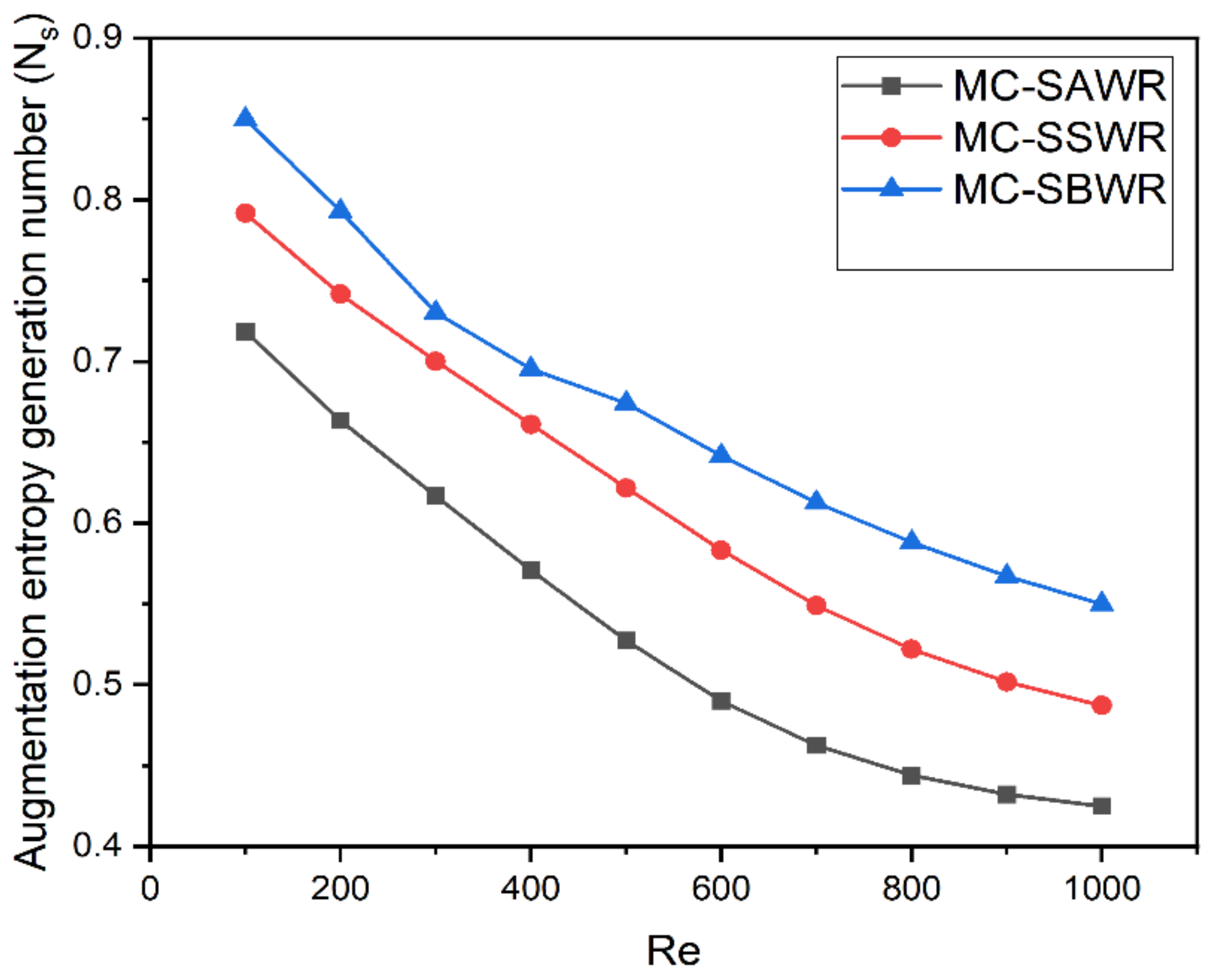


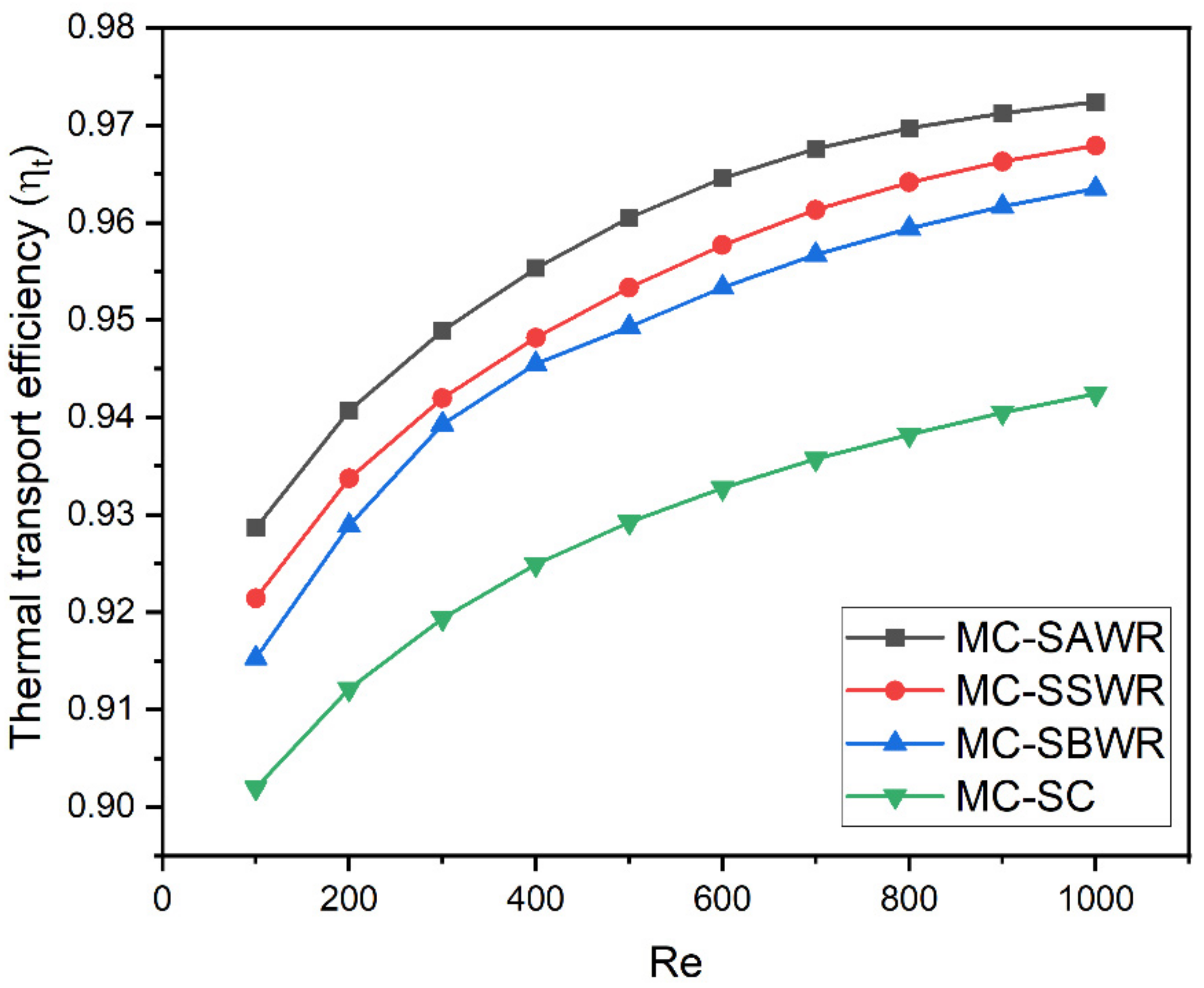
| Properties | Materials | |
|---|---|---|
| Copper | Water | |
| Density | 8978 | 998.2 |
| Specific heat | 381 | 4182 |
| Thermal conductivity | 387.6 | 0.6 |
| Dynamic viscosity | 0.001003 | |
| Inlet velocity Inlet temperature | |
| Outlet pressure | |
| Heat flux at y = 0 | |
| At solid–liquid interface | |
| Adiabatic boundary |
| S. No | Grid Resolution | Element Size (mm) | Grid Number |
|---|---|---|---|
| 1 | Coarse mesh | 0.058 | 379,267 |
| 2 | Medium | 0.048 | 661,025 |
| 3 | Fine | 0.045 | 810,563 |
| 4 | Very fine | 0.041 | 1,058,252 |
Disclaimer/Publisher’s Note: The statements, opinions and data contained in all publications are solely those of the individual author(s) and contributor(s) and not of MDPI and/or the editor(s). MDPI and/or the editor(s) disclaim responsibility for any injury to people or property resulting from any ideas, methods, instructions or products referred to in the content. |
© 2023 by the authors. Licensee MDPI, Basel, Switzerland. This article is an open access article distributed under the terms and conditions of the Creative Commons Attribution (CC BY) license (https://creativecommons.org/licenses/by/4.0/).
Share and Cite
Akhtar, K.; Ali, H.; Ud Din, I.; Abbas, A.; Zahir, M.Z.; Ahmad, F.; Alam, F.; Shah, N.; Aamir, M. Heat Transfer Augmentation and Entropy Generation Analysis of Microchannel Heat Sink (MCHS) with Symmetrical Ogive-Shaped Ribs. Energies 2023, 16, 2783. https://doi.org/10.3390/en16062783
Akhtar K, Ali H, Ud Din I, Abbas A, Zahir MZ, Ahmad F, Alam F, Shah N, Aamir M. Heat Transfer Augmentation and Entropy Generation Analysis of Microchannel Heat Sink (MCHS) with Symmetrical Ogive-Shaped Ribs. Energies. 2023; 16(6):2783. https://doi.org/10.3390/en16062783
Chicago/Turabian StyleAkhtar, Kareem, Haseeb Ali, Israr Ud Din, Azed Abbas, Muhammad Zeeshan Zahir, Faraz Ahmad, Fayyaz Alam, Nasir Shah, and Muhammad Aamir. 2023. "Heat Transfer Augmentation and Entropy Generation Analysis of Microchannel Heat Sink (MCHS) with Symmetrical Ogive-Shaped Ribs" Energies 16, no. 6: 2783. https://doi.org/10.3390/en16062783









